Fire lance

The fire lance (simplified Chinese: 火枪; traditional Chinese: 火槍; pinyin: huǒ qiāng) was a very early gunpowder weapon that appeared in 10th century China during the Jin-Song Wars. It began as a small pyrotechnic device attached to a spear-like weapon, used to gain a critical shock advantage right at the start of a melee.[1] As gunpowder improved, the explosive discharge was increased, and debris or pellets added, giving it some of the effects of a combination modern flamethrower and shotgun, but with a very short range (3 meters or less), and only one shot (some were designed for two shots). In later larger and more powerful fire lances, the lance-point was discarded, as these versions were too unwieldy to be used in melee. These are considered to be a proto-gun, the predecessor of the hand cannon, and the ancestor of all firearms.[2] Fire lances that were too large for a single man to wield, and were emplaced upon the ground in a supporting framework; these can be considered a proto-cannon.
Design
The first fire lances consisted of a tube, usually bamboo, containing gunpowder and a slow match, strapped to a spear or other polearm weapon. Once ignited, the gunpowder tube would ideally eject a stream of flames in the direction of the spearhead. Co-viative projectiles such as iron pellets or pottery shards were later added to the gunpowder. Upon firing, the gunpowder charge ejected the projectiles along with the flame.[3]
Metal fire lance barrels appeared around the mid 13th century and these began to be used independently of the lance itself. The independent metal barrel was known as an 'eruptor' and became the forerunner of the hand cannon.[3]
History
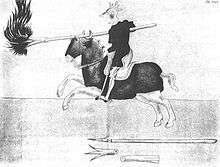
The first evidence of fire lances appeared in China in the year 950 and fire lances were also mentioned in the military text Wujing Zongyao of 1044. However usage of fire lances in warfare was not mentioned until 1132 when Song garrisons used them during the Siege of De'an, in modern-day Anlu, Hubei, when fire lance troops led the vanguard in a sortie against the Jin dynasty (1115–1234).[4][5][6]
In 1163 fire lances were attached to war carts known as "at-your-desire-carts" used to defend mobile firebomb trebuchets.[1]
In the late 1100s pieces of shrapnel such as porcelain shards and small iron pellets were added to the gunpowder tube. At some point fire lances discarded the spearhead altogether and relied solely on their firepower.[7]
By 1232 the Jin were also using fire lances, but with improved reusable barrels consisting of durable paper material. According to the History of Jin, these fire lances had a range of roughly three meters:
To make the lance, use chi-huang paper, sixteen layers of it for the tube, and make it a bit longer than two feet. Stuff it with willow charcoal, iron fragments, magnet ends, sulfur, white arsenic [probably an error that should mean saltpeter], and other ingredients, and put a fuse to the end. Each troop has hanging on him a little iron pot to keep fire [probably hot coals], and when it's time to do battle, the flames shoot out the front of the lance more than ten feet, and when the gunpowder is depleted, the tube isn't destroyed.[8]
The Mongol soldiers which they were used against were apparently disdainful of other Jin weapons, but greatly feared the fire lance. Jin soldiers also used them in open combat and in one instance, a contingent of 450 fire lancers routed an entire Mongol encampment.[9]
In 1259 a pellet wad that occluded the barrel was recorded to have been used as a fire lance projectile, making it the first recorded bullet in history.[7]
By 1276 fire lances had transitioned to metal barrels.[10]
The metal-barreled fire lance began to be used independently of the lance around the mid to late 13th century. These proto-cannons which fired co-viative projectiles, known as 'eruptors,' were the forerunners of the hand cannon.[7]
By 1280 the Middle East had acquired fire lances.[11]
In 1396 European knights took up fire lances as mounted weapons.[12]
The last recorded usage of fire lances in Europe occurred during the Storming of Bristol in 1643.[13]
Gallery

 A fire lance from the Wubei Zhi.
A fire lance from the Wubei Zhi.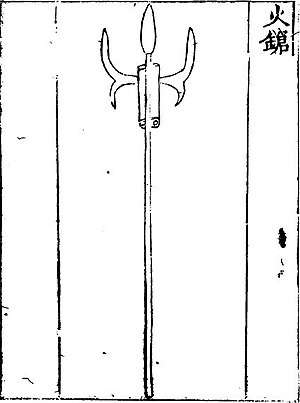 A double barreled fire lance from the Huolongjing. Supposedly they fired in succession, and the second one is lit automatically after the first barrel finishes firing.
A double barreled fire lance from the Huolongjing. Supposedly they fired in succession, and the second one is lit automatically after the first barrel finishes firing.- The phalanx-charging fire-gourd, one of many fire lance types discharging lead pellets in the gunpowder blast, an illustration from the Huolongjing.
 An 'awe-inspiring fierce-fire yaksha gun' as depicted in the Huolongjing.
An 'awe-inspiring fierce-fire yaksha gun' as depicted in the Huolongjing. A 'lotus bunch' as depicted in the Huolongjing. It is a bamboo tube firing darts along with flames.
A 'lotus bunch' as depicted in the Huolongjing. It is a bamboo tube firing darts along with flames.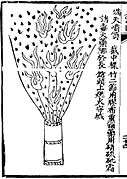 A 'sky-filling spurting-tube' as depicted in the Huolongjing. A bamboo tube filled with a mixture of gunpowder and porcelain fragments.
A 'sky-filling spurting-tube' as depicted in the Huolongjing. A bamboo tube filled with a mixture of gunpowder and porcelain fragments. A 'bandit-striking penetrating gun' as depicted in the Huolongjing. The first known metal barreled fire lance, it throws low nitrate gunpowder flames along with coviative missiles.
A 'bandit-striking penetrating gun' as depicted in the Huolongjing. The first known metal barreled fire lance, it throws low nitrate gunpowder flames along with coviative missiles.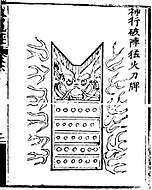 A 'divine moving phalanx-breaking fierce-fire sword-shield' as depicted in the Huolongjing. A mobile shield fitted with fire lances used to break enemy formations.
A 'divine moving phalanx-breaking fierce-fire sword-shield' as depicted in the Huolongjing. A mobile shield fitted with fire lances used to break enemy formations.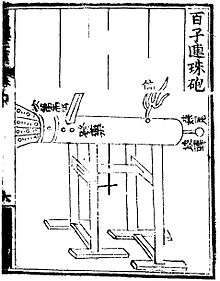 Essentially a fire lance on a frame, the 'multiple bullets magazine eruptor' shoots lead shots, which are loaded in a magazine and fed into the barrel when turned around on its axis.
Essentially a fire lance on a frame, the 'multiple bullets magazine eruptor' shoots lead shots, which are loaded in a magazine and fed into the barrel when turned around on its axis.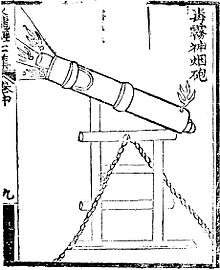 A 'poison fog magic smoke eruptor' as depicted in the Huolongjing. Small shells emitting poisonous smoke are fired.
A 'poison fog magic smoke eruptor' as depicted in the Huolongjing. Small shells emitting poisonous smoke are fired.- The 'flying-cloud thunderclap-eruptor' cannon from the Huolongjing.
 Illustrations of fire lances from De la pirotechnia by Vannoccio Biringuccio ca. 1540.
Illustrations of fire lances from De la pirotechnia by Vannoccio Biringuccio ca. 1540.
See also
Citations
- 1 2 Andrade 2016, p. 38.
- ↑ Andrade 2016, p. 33.
- 1 2 Andrade 2016, p. 51.
- ↑ Needham 1986, p. 222.
- ↑ Chase 2003, p. 31.
- ↑ Lorge 2008, p. 33-34.
- 1 2 3 Andrade 2016, p. 52.
- ↑ Andrade 2016, p. 46.
- ↑ Andrade 2016, p. 47.
- ↑ Needham 1986, p. 228.
- ↑ Needham 1986, p. 259.
- ↑ Needham 1986, p. 260.
- ↑ Needham 1986, p. 262.
- ↑ "The Genius of China", Robert Temple
References
- Adle, Chahryar (2003), History of Civilizations of Central Asia: Development in Contrast: from the Sixteenth to the Mid-Nineteenth Century
- Ágoston, Gábor (2008), Guns for the Sultan: Military Power and the Weapons Industry in the Ottoman Empire, Cambridge University Press, ISBN 0-521-60391-9
- Agrawal, Jai Prakash (2010), High Energy Materials: Propellants, Explosives and Pyrotechnics, Wiley-VCH
- Andrade, Tonio (2016), The Gunpowder Age: China, Military Innovation, and the Rise of the West in World History, Princeton University Press, ISBN 978-0-691-13597-7 .
- Arnold, Thomas (2001), The Renaissance at War, Cassell & Co, ISBN 0-304-35270-5
- Benton, Captain James G. (1862). A Course of Instruction in Ordnance and Gunnery (2 ed.). West Point, New York: Thomas Publications. ISBN 1-57747-079-6.
- Brown, G. I. (1998), The Big Bang: A History of Explosives, Sutton Publishing, ISBN 0-7509-1878-0 .
- Buchanan, Brenda J., ed. (2006), Gunpowder, Explosives and the State: A Technological History, Aldershot: Ashgate, ISBN 0-7546-5259-9
- Chase, Kenneth (2003), Firearms: A Global History to 1700, Cambridge University Press, ISBN 0-521-82274-2 .
- Cocroft, Wayne (2000), Dangerous Energy: The archaeology of gunpowder and military explosives manufacture, Swindon: English Heritage, ISBN 1-85074-718-0
- Cowley, Robert (1993), Experience of War, Laurel .
- Cressy, David (2013), Saltpeter: The Mother of Gunpowder, Oxford University Press
- Crosby, Alfred W. (2002), Throwing Fire: Projectile Technology Through History, Cambridge University Press, ISBN 0-521-79158-8 .
- Curtis, W. S. (2014), Long Range Shooting: A Historical Perspective, WeldenOwen .
- Earl, Brian (1978), Cornish Explosives, Cornwall: The Trevithick Society, ISBN 0-904040-13-5 .
- Easton, S. C. (1952), Roger Bacon and His Search for a Universal Science: A Reconsideration of the Life and Work of Roger Bacon in the Light of His Own Stated Purposes, Basil Blackwell
- Ebrey, Patricia B. (1999), The Cambridge Illustrated History of China, Cambridge University Press, ISBN 0-521-43519-6
- Grant, R.G. (2011), Battle at Sea: 3,000 Years of Naval Warfare, DK Publishing .
- Hadden, R. Lee. 2005. "Confederate Boys and Peter Monkeys." Armchair General. January 2005. Adapted from a talk given to the Geological Society of America on March 25, 2004.
- Harding, Richard (1999), Seapower and Naval Warfare, 1650-1830, UCL Press Limited
- al-Hassan, Ahmad Y. (2001), "Potassium Nitrate in Arabic and Latin Sources", History of Science and Technology in Islam, retrieved 23 July 2007 .
- Hobson, John M. (2004), The Eastern Origins of Western Civilisation, Cambridge University Press .
- Johnson, Norman Gardner. "explosive". Encyclopædia Britannica. Chicago: Encyclopædia Britannica Online.
- Kelly, Jack (2004), Gunpowder: Alchemy, Bombards, & Pyrotechnics: The History of the Explosive that Changed the World, Basic Books, ISBN 0-465-03718-6 .
- Khan, Iqtidar Alam (1996), "Coming of Gunpowder to the Islamic World and North India: Spotlight on the Role of the Mongols", Journal of Asian History, 30: 41–5 .
- Khan, Iqtidar Alam (2004), Gunpowder and Firearms: Warfare in Medieval India, Oxford University Press
- Khan, Iqtidar Alam (2008), Historical Dictionary of Medieval India, The Scarecrow Press, Inc., ISBN 0-8108-5503-8
- Kinard, Jeff (2007), Artillery An Illustrated History of its Impact
- Konstam, Angus (2002), Renaissance War Galley 1470-1590, Osprey Publisher Ltd. .
- Liang, Jieming (2006), Chinese Siege Warfare: Mechanical Artillery & Siege Weapons of Antiquity, Singapore, Republic of Singapore: Leong Kit Meng, ISBN 981-05-5380-3
- Lidin, Olaf G. (2002), Tanegashima – The Arrival of Europe in Japan, Nordic Inst of Asian Studies, ISBN 8791114128
- Lorge, Peter A. (2008), The Asian Military Revolution: from Gunpowder to the Bomb, Cambridge University Press, ISBN 978-0-521-60954-8
- Lu, Gwei-Djen (1988), "The Oldest Representation of a Bombard", Technology and Culture, 29: 594–605
- McLachlan, Sean (2010), Medieval Handgonnes
- McNeill, William Hardy (1992), The Rise of the West: A History of the Human Community, University of Chicago Press .
- Morillo, Stephen (2008), War in World History: Society, Technology, and War from Ancient Times to the Present, Volume 1, To 1500, McGraw-Hill, ISBN 978-0-07-052584-9
- Needham, Joseph (1980), Science & Civilisation in China, 5 pt. 4, Cambridge University Press, ISBN 0-521-08573-X
- Needham, Joseph (1986), Science & Civilisation in China, V:7: The Gunpowder Epic, Cambridge University Press, ISBN 0-521-30358-3 .
- Nicolle, David (1990), The Mongol Warlords: Ghengis Khan, Kublai Khan, Hulegu, Tamerlane
- Nolan, Cathal J. (2006), The Age of Wars of Religion, 1000–1650: an Encyclopedia of Global Warfare and Civilization, Vol 1, A-K, 1, Westport & London: Greenwood Press, ISBN 0-313-33733-0
- Norris, John (2003), Early Gunpowder Artillery: 1300–1600, Marlborough: The Crowood Press .
- Partington, J. R. (1960), A History of Greek Fire and Gunpowder, Cambridge, UK: W. Heffer & Sons .
- Partington, J. R. (1999), A History of Greek Fire and Gunpowder, Baltimore: Johns Hopkins University Press, ISBN 0-8018-5954-9
- Patrick, John Merton (1961), Artillery and warfare during the thirteenth and fourteenth centuries, Utah State University Press .
- Pauly, Roger (2004), Firearms: The Life Story of a Technology, Greenwood Publishing Group .
- Perrin, Noel (1979), Giving up the Gun, Japan's reversion to the Sword, 1543–1879, Boston: David R. Godine, ISBN 0-87923-773-2
- Petzal, David E. (2014), The Total Gun Manual (Canadian edition), WeldonOwen .
- Phillips, Henry Prataps (2016), The History and Chronology of Gunpowder and Gunpowder Weapons (c.1000 to 1850), Notion Press
- Purton, Peter (2010), A History of the Late Medieval Siege, 1200–1500, Boydell Press, ISBN 1-84383-449-9
- Robins, Benjamin (1742), New Principles of Gunnery
- Rose, Susan (2002), Medieval Naval Warfare 1000-1500, Routledge
- Roy, Kaushik (2015), Warfare in Pre-British India, Routledge
- Schmidtchen, Volker (1977a), "Riesengeschütze des 15. Jahrhunderts. Technische Höchstleistungen ihrer Zeit", Technikgeschichte 44 (2): 153–173 (153–157)
- Schmidtchen, Volker (1977b), "Riesengeschütze des 15. Jahrhunderts. Technische Höchstleistungen ihrer Zeit", Technikgeschichte 44 (3): 213–237 (226–228)
- Swope, Kenneth M. (2013), The Military Collapse of China's Ming Dynasty, 1618-44 (Asian States and Empires), Routledge .
- Tran, Nhung Tuyet (2006), Viêt Nam Borderless Histories, University of Wisconsin Press .
- Turnbull, Stephen (2003), Fighting Ships Far East (2: Japan and Korea Ad 612-1639, Osprey Publishing, ISBN 1-84176-478-7
- Urbanski, Tadeusz (1967), Chemistry and Technology of Explosives, III, New York: Pergamon Press .
- Villalon, L. J. Andrew (2008), The Hundred Years War (part II): Different Vistas, Brill Academic Pub, ISBN 978-90-04-16821-3
- Wagner, John A. (2006), The Encyclopedia of the Hundred Years War, Westport & London: Greenwood Press, ISBN 0-313-32736-X
- Watson, Peter (2006), Ideas: A History of Thought and Invention, from Fire to Freud, Harper Perennial (2006), ISBN 0-06-093564-2
- Willbanks, James H. (2004), Machine guns: an illustrated history of their impact, ABC-CLIO, Inc.
External links
- Little Bit of Info on the Fire Lance
- Medieval Chinese Armies, 1260-1520 (Men-at-arms S.) by Chris J. Peers. ISBN 1-85532-599-3
- Chinese Siege Warfare: Mechanical Artillery & Siege Weapons of Antiquity